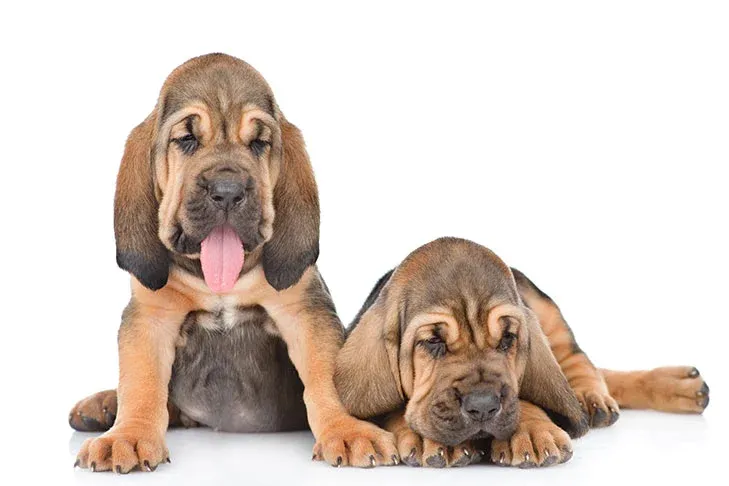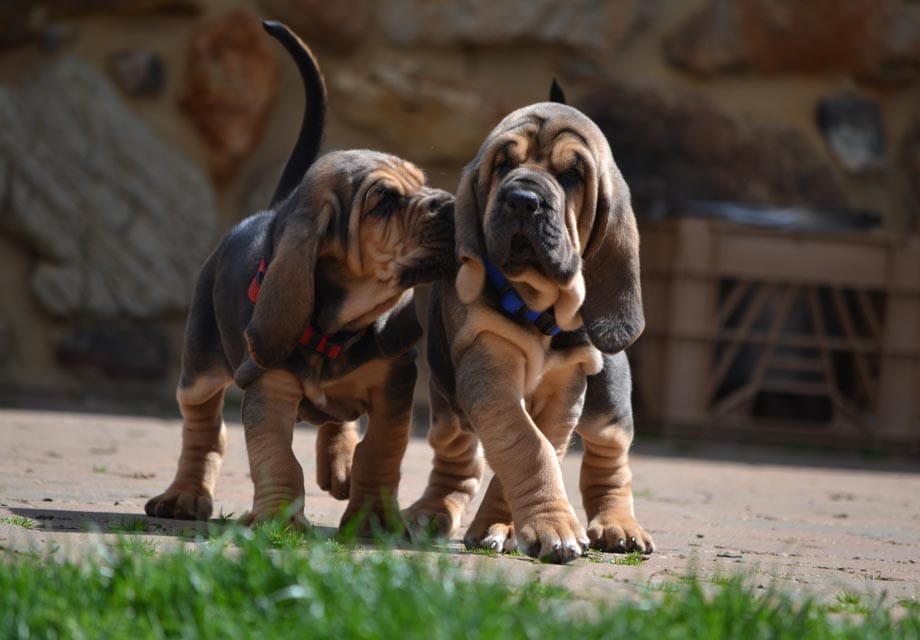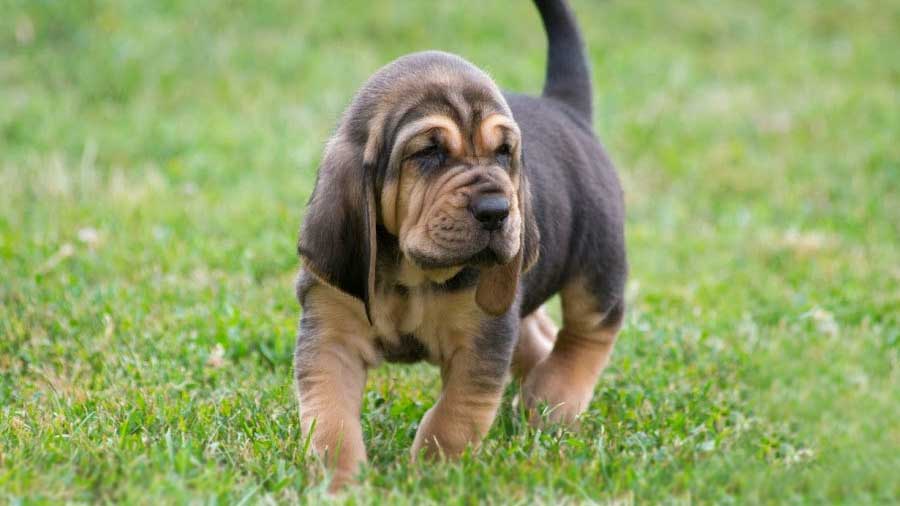Bloodhound puppies, known for their exceptional tracking abilities and distinctive appearance, exhibit what many would consider a high level of energy, typical of the developmental stages of many dog breeds. Their innate curiosity and strong instinctual drives can lead to what appears as hyperactivity, particularly during their early months. It's common for these puppies to have bursts of energy followed by periods of rest. Proper training and socialization are crucial in directing their energy positively and preventing potential behavioral issues.

Understanding a bloodhound's needs is essential for managing their energy levels. They require regular exercise, mental stimulation, and a consistent training regime to keep their active minds and bodies engaged. Without adequate activity, bloodhounds, especially in their puppy phase, may become restless and exhibit hyperactive behaviors. Their eagerness to explore and follow scents can sometimes be misinterpreted as hyperactivity when, in fact, it's a natural expression of their breed traits.
Owners should be prepared to invest time and effort into structured activities that cater to a bloodhound's instinctual behaviors. Activities such as scent games, tracking exercises, and ample outdoor playtime can help channel a puppy's vigor in a productive manner. It's also important to establish a routine, which can help bloodhound puppies learn to regulate their excitement and energy, allowing them to mature into well-adjusted adult dogs.

Bloodhound Breed Overview
The Bloodhound is a large and distinctive hound known for its remarkable tracking abilities. This breed presents an intriguing mix of physical traits and a well-documented lineage, bearing a temperament that balances nobility with a loving nature. Health aspects are also notable, especially given their size and distinctive appearance.
Breed History
The Bloodhound's history stretches back to medieval France, linked closely to the monks of St. Hubert. Bloodhounds were refined over centuries, originally used for tracking deer and boar. Their keen scent abilities later made them invaluable for tracking people, a role they continue to be recognized for today.
Physical Characteristics
Characterized by their large frame, Bloodhounds possess a notable black and tan, liver and tan, or red coat. Their appearance is distinguished by deep-set eyes, long, drooping ears, and wrinkles with loose skin enhancing their facial expressions. The nails should be strong and the teeth well set, as befits a robust breed.
Temperament and Personality
Bloodhounds display a noble and gentle nature, often described as patient, affectionate, and loving. Their personality is a mix of a strong sense of purpose with a stubborn streak. Highly sensitive to their owners' emotions, Bloodhounds are socially inclined and thrive on companionship.
Health and Lifespan
A Bloodhound's health is generally robust, but care from a knowledgeable veterinarian is essential to address common breed concerns like bloat. Regular check-ups and a proper diet contribute to a healthy life. Typically, their lifespan ranges between 10 and 12 years.
Understanding Puppy Behavior
When examining Bloodhound puppy behavior, it's fundamental to consider their natural energy levels, personality traits, and the challenges they present to owners.
Typical Energy Levels
Bloodhound puppies exhibit a high energy level, which manifests in their love for activity. They require regular exercise to satisfy their active lifestyles. A structured routine that includes:
- Daily walks
- Playtime with toys
- Training sessions
...is essential to channel their energetic disposition constructively.
Behavioral Traits
Bloodhounds are known for a personality that can be playful and sensitive. Their temperament generally includes:
- A strong inclination to chew, highlighting the need for durable chew toys.
- An eagerness for attention and interaction with their human counterparts.
- A tendency to be stubborn, which can require patience and consistent training methods.
Common Challenges
Noise, including baying and howling, can be a common behavioral challenge with Bloodhound puppies, as they often use their voice to communicate. To mitigate excessive noise:
- Ensure they have sufficient physical and mental stimulation.
- Acknowledge their vocalizations without reinforcing the behavior.
Owners should also prepare for the attention these puppies need. Without it, they may become hyper and engage in unwanted behaviors. Early socialization and obedience training are critical in overcoming these challenges.

Proper Care for Bloodhound Puppies
Caring for bloodhound puppies involves a dedicated approach to meeting their dietary, exercise, and grooming needs. These components are foundational to their health and well-being.
Diet and Nutrition
Optimal food: Bloodhound puppies require a balanced diet rich in proteins, fats, and carbohydrates to support their rapid growth and high energy levels. Consult with a veterinarian to determine the right dog food and portion sizes.
- Weaning to 3 months: 4–6 small meals per day.
- 3 to 6 months: 3 meals per day.
- 6 months and older: 2 meals per day.
Water:
- Always have fresh water available.
Exercise Requirements
Daily activity: They need considerable daily exercise to maintain physical health and prevent behavioral issues.
Exercise types:
- Long walks twice a day.
- Structured playtime in a securely fenced area.
Space: Ensure sufficient space for running and exploration, as bloodhounds have a natural instinct to track scents.
Grooming Needs
Coat care: Their short coat requires regular brushing to minimize shedding and distribute natural oils.
Drool management: Due to their tendency to drool, it's important to regularly clean their facial wrinkles to prevent skin infections.
Bathing:
- Monthly baths are recommended, unless the dog gets particularly dirty.
Regular grooming keeps the bloodhound clean and comfortable.
Training and Socialization
Training and socialization are crucial for shaping a well-behaved and sociable bloodhound puppy. Effective training strategies involve patience and consistency, while early socialization sets the foundation for a well-rounded temperament.
Training Techniques
Consistent Commands: A bloodhound puppy responds best to clear and consistent commands such as sit, stay, down, come, and leash training. It's essential to start with one command at a time and use positive reinforcement such as praise or treats to reward desired behavior.
- Patience is Key: Training must be approached with patience, as bloodhounds can be stubborn.
- Short Sessions: Keep training sessions brief to maintain the puppy's attention.
Importance of Socialization
Early Exposure: Introduce the bloodhound puppy to a variety of people, animals, and environments early on. Progressive exposure to different stimuli helps the puppy become accustomed to various sounds and situations, aiding in proper behavioral development.
- Company and Play: Regular interaction with humans and other animals is vital. Encourage gentle play and supervised interaction to promote social skills.
- Diverse Environments: Exposure to different locations and experiences prevents future anxiety and fear.
Activities Suitable for Bloodhound Puppies
Bloodhound puppies thrive on activities that utilize their natural abilities and satisfy their high energy levels. Choosing the right activities can help in their physical and mental development.
Scent Work and Tracking
Bloodhound puppies possess a keen sense of smell and can be introduced early to scent work for mental stimulation and exercise. Initiating simple scent games can lay the foundation for more complex tracking activities.
- Starting Scent Work: Begin with basic scent games such as hiding treats around the house and encouraging the puppy to find them using their nose.
- Tracking Trails: As the puppy matures, create short scent trails outdoors using different scents, such as essential oils or safe food-based scents. Over time, these trails can become more intricate, imitating hunting or law enforcement tracking scenarios.
Games and Playtime
The playful nature of bloodhound puppies means that games and playtime can be an effective way to burn excess energy and provide enjoyment.
- Interactive Toys: Introduce a variety of toys that stimulate their minds, such as puzzles that release treats when solved.
- Chew Toys: Provide durable chew toys to satisfy their need to gnaw, which can help in dental health and prevent destructive chewing of household items.
- Structured Play: Engage in structured play sessions where the puppy is encouraged to fetch, tug, or chase, facilitating both exercise and bonding time.
Creating a Supportive Environment
Creating a supportive environment is essential for a Bloodhound puppy to thrive, focusing on adequate space and attentive companionship.
Home and Space Requirements
Bloodhound puppies require a spacious environment where they can explore and expend their energy. A puppy needs plenty of room both inside the home and outside.
- Indoors: Ensure the home is puppy-proofed with a designated area for the Bloodhound to sleep and play safely.
- Outdoors: A securely fenced yard is necessary to allow the puppy to roam without the risk of escape.
Space inside the home should be free of hazards, and items the puppy could chew on should be kept out of reach. The Bloodhound's environment must be safe and enriching to support its development.

Living with a Bloodhound
Bloodhounds are known for being easygoing and sometimes lazy, but as puppies, they are quite active and need plenty of attention.
- Companionship: They thrive on being part of the family and should not be left alone for extended periods.
- Attention: Regular interaction and playtime are crucial for their social development.
In the household, Bloodhounds require consistent company and engage well with structured training to cater to their attention needs.
Potential Health Considerations
When considering the health of Bloodhound puppies, prospective owners should be aware of breed-specific health issues and the importance of preventative care.
Common Health Issues
Bloat: Bloodhounds are susceptible to gastric torsion, also known as bloat, which is a life-threatening condition. Immediate veterinary attention is crucial in such cases.
Ear Infections: Due to their long, floppy ears, Bloodhounds are prone to ear infections. Regular cleaning and monitoring can help prevent such issues.
Eye Conditions: Disorders like entropion or ectropion can affect Bloodhounds. These conditions require a vet's diagnosis and may need surgical intervention.
Preventative Care Measures
Regular Veterinary Visits: Routine check-ups with a veterinarian can help catch and treat health issues early on.
Diet and Exercise: A balanced diet and regular exercise regime are essential in maintaining a Bloodhound puppy's health and mitigating the risk of bloat.
Grooming: Consistent grooming is vital to keep their long ears clean, reducing the risk of infections, and to maintain general hygiene.
Adopting a Bloodhound Puppy
Adopting a bloodhound puppy is a commitment that involves careful consideration of where the puppy comes from. Whether through a breeder or a rescue group, the choice must align with the prospective owner's values and the well-being of the dog.
Finding a Reputable Breeder
When seeking to adopt a bloodhound puppy, identifying a reputable breeder is crucial. A responsible breeder prioritizes the health and temperament of their dogs, and they are often affiliated with breed clubs or organizations.
Key Factors When Choosing a Breeder:
- Health Screenings: Ensure that the breeder conducts thorough health checks and provides health clearances for the puppies and their parents.
- Environment: Visit the premises to confirm that the puppies are raised in a clean, safe, and loving environment.
- Knowledge: A reputable breeder should possess extensive knowledge about bloodhounds and be able to discuss the breed's specific needs and characteristics.
- Support: Look for breeders who offer guidance and support for the lifetime of the dog, demonstrating their commitment to the breed and to their puppies' long-term welfare.
Rescue and Adoption
Choosing to adopt a bloodhound puppy from a rescue group can be a heartfelt decision that gives a puppy a second chance at life. Rescue groups often have dogs of all ages, from puppies to seniors, in need of new homes.
Advantages of Adopting from a Rescue Group:
- Affectionate Companions: Many rescued bloodhounds are affectionate and eager to bond with a new family.
- Contribution to Welfare: Adopting from a rescue contributes to the welfare of all dogs by supporting the efforts of rescue groups.
- Informed Choice: Rescue groups can provide detailed information about the puppy's personality and behavior, as many rescue dogs are assessed in foster homes before adoption.
When adopting a bloodhound puppy, whether from a breeder or a rescue, it is important to be prepared for the responsibility of raising an energetic and affectionate companion. This includes considering the puppy's long-term needs and the commitment required to provide a stable, loving home.
Frequently Asked Questions
Bloodhound puppies are known for their vigor and stamina; typical of their breed, they require appropriate guidance to manage their energetic nature.

- What age does a Bloodhound typically become less energetic?
- A Bloodhound usually becomes less energetic as they reach their mature adult years, around the age of two to three. However, this can vary from dog to dog.
- How can you effectively calm down a Bloodhound puppy?
- Calming a Bloodhound puppy can be achieved through consistent crate training, regular exercise, and establishing a calm environment. Mental stimulation through puzzle toys or scent games also helps in calming them.
- Is it challenging to train Bloodhound puppies due to their energy levels?
- Training Bloodhound puppies can be more demanding due to their high energy. Firm, consistent training from an early age, paired with positive reinforcement, can address this challenge effectively.
- Do Bloodhounds require a lot of exercise to manage their liveliness?
- Yes, Bloodhounds require significant exercise to manage their high energy levels. Long walks, playtime in a secure area, and scent-tracking activities can help in expending their vitality.
- Are Bloodhound puppies generally considered energetic compared to other breeds?
- Bloodhound puppies are indeed more energetic compared to many other breeds. Their breeding for stamina and endurance contributes to their high-energy nature.
- How does the hunting instinct of Bloodhounds affect their activity levels?
- The hunting instinct of Bloodhounds contributes significantly to their activity levels, leading to a need for ample physical and mental engagement. Their natural drive to track scents necessitates activities that can harness this behavior productively.




